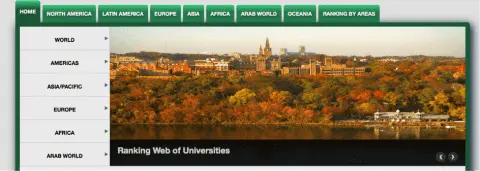The following article is archived and is no longer considered up-to-date. Please interpret its content in the context of the publishing date.

ARCHIVED
Web Rankings for Universities: How to Secure a Top Spot
Read a summary using the INOMICS AI tool
While everyone knows how important a good spot in the major rankings lists can be for recruiting top-notch students, another type of ranking is gaining in momentum that deserves widespread recognition as well. In the digital era we find ourselves in, it’s only appropriate that cyber rankings be given weight within a school’s overall reputation. To do well on this scale means more than just having a flashy website, however; it means creating a user-friendly, active and interactive online presence for your institution, while retaining staff who publish widely and share their work and ideas with the public via online platforms.
The “Webometrics Ranking of World Universities” was developed in the Cybermetrics Lab at the CSIC, the largest public research body in Spain and one of the first research organizations in Europe. This new system of university ranking uses quantitative methods to analyze various indicators including social networks, web resources, scientific communication via electronic journals, scholarly activity on the internet, search engine positions of domain names and web log files. Since 2004, the Cybermetrics lab has been building their database and performing transparent, independent analysis regarding the web impact of universities around the world.
Cybermetrics underscores on their website that the aim of their ranking system is not to compare institutions based on website popularity or number of unique visitors, but rather to promote the Open Access initiatives for increasing the availability of scientific knowledge. With the rise of distance learning and online courses, a clear space for knowledge sharing can set a university apart from its peers.
So how can you enhance your position on this up and coming ranking system? Many university faculty are happy to share their papers and research with interested parties, but don’t regularly do so without prompting. Here are a few ways to increase your internet visibility in the name of knowledge sharing and securing a good spot on the Webometrics Ranking:
- Encourage professors and researchers to make their work publicly available
- Make sure all websites are up to date, including CVs and links
- Create clear spaces for open access content: share lectures, papers, reports
- Provide platforms for students to share their work and interact with each other
Finally, Webometrics Ranking is not without flaws – for instance, they only use the top 500 institutions from a given country, meaning that universities with vast resources tend to head the ranking lists, as they do the traditional lists. Cybermetrics does offer comprehensive breakdowns by region, however, allowing for detailed comparisons within any given part of the world. For instance, while Harvard may have snagged the global number one spot, it’s quite useful to be able to narrow your search and note that the University of Sao Paolo leads the pack for Latin America, or the National Taiwan University for Asia.
We predict that this type of ranking will gain importance as global connectivity continues to increase, so it’s time to be proactive and put your institution on the Webometrics map!
Photo credit: Webometrics
-
- Summer School
- Posted 1 week ago
Max Planck Summer School on the Political Economy of Conflict and Redistribution 2026
Starts 7 Sep at Max Planck Institute for Tax Law and Public Finance in Berlin, Germany
-
- Postdoc Job
- Posted 1 week ago
Postdoctoral Researcher in Behavioral/ Experimental Economics (m/f/d)
At Düsseldorf Institute for Competition Economics (DICE) - University of Düsseldorf in Düsseldorf, Germany
-
- Conference
- Posted 1 week ago
Call for Papers 2026 Vienna-Copenhagen Conference on Financial Econometrics
Between 13 Aug and 15 Aug in Vienna, Austria











